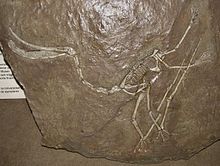
Back Euctenochasmatia French Euctenochasmatia Italian Euctenochasmatia Dutch Euctenochasmatia Ukrainian
| Euctenochasmatians Temporal range: Late Jurassic - Early Cretaceous,
| |
|---|---|

| |
| Cast of the sub-adult type specimen of the basal member Pterodactylus antiquus | |

| |
| Cast of fossil specimen of the ctenochasmatid Pterodaustro guinazui | |
| Scientific classification | |
| Domain: | Eukaryota |
| Kingdom: | Animalia |
| Phylum: | Chordata |
| Order: | †Pterosauria |
| Suborder: | †Pterodactyloidea |
| Infraorder: | †Archaeopterodactyloidea |
| Clade: | †Euctenochasmatia Unwin, 2003 |
| Subgroups | |
Euctenochasmatia is an extinct group of pterodactyloid pterosaurs. It was named by David Unwin in 2003 as the group that contains the most recent common ancestor of Pterodactylus and Ctenochasma, and all their descendants.[1]
Euctenochasmatians were specialized pterosaurs that had elongated necks as well as specialized teeth. A peculiar family within this group is the Ctenochasmatidae, which most of the members had very distinguishing teeth that were lined within their elongated snouts.[2] A genus called Pterofiltrus only had 112 teeth, but these teeth cover about 55.8% of the total skull, and the skull itself measured about 208 millimeters (8.2 in) in length.[3]
- ^ Vidovic, S.U.; Martill, D.M. (2017). "The taxonomy and phylogeny of Diopecephalus kochi (Wagner, 1837) and "Germanodactylus rhamphastinus" (Wagner, 1851)". Geological Society, London, Special Publications. 455: 125–147. doi:10.1144/SP455.12. S2CID 219204038.
- ^ Wilton, Mark P. (2013). Pterosaurs: Natural History, Evolution, Anatomy. Princeton University Press. ISBN 978-0691150611.
- ^ Jiang Shunxing and Wang Xiaolin (2011). "A new ctenochasmatid pterosaur from the Lower Cretaceous, western Liaoning, China" (PDF). Anais da Academia Brasileira de Ciências. 83 (4): 1243–1249. doi:10.1590/s0001-37652011000400011. ISSN 0001-3765. PMID 22146956.
© MMXXIII Rich X Search. We shall prevail. All rights reserved. Rich X Search